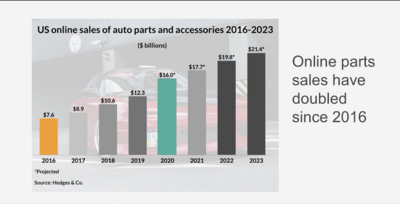BUSINESS
Keys for Driving Internet Sales
Practical Advice for Retailers Looking to Increase Online Market Share
By Douglas McColloch

SEMA Data Vice President of Operations Gigi Ho (left) led a discussion of online sales with former Motovicity CEO Brian Lounsberry to discuss best practices for online retailers. Lounsberry’s 25 years of experience spans sales, marketing, IT, software and executive management.
The onset of the COVID-19 pandemic in spring 2020 and the ensuing quarantines and lockdowns it occasioned highlighted the need for companies to build and maintain a robust online infrastructure to optimize consumer outreach and leverage sales when conventional retailing methods aren’t an option. Online sales of specialty-equipment products represented more than half of all parts sales in calendar year 2020, and while that number has declined as retail stores have reopened for business, online sales still account for 40%–45% of all sales in the industry. That fact presents challenges and opportunities for specialty-equipment companies looking to expand their digital footprint to drive brand awareness and sales.
A recent SEMA Education seminar, “Tactics to Increase Online Market Share,” took a closer look at the subject, with an informal discussion aimed at diagnosing trouble spots that may arise for businesses and recommending best practices for optimizing online retail sales. The discussion was hosted by SEMA Data Vice President of Operations Gigi Ho and featured Brian Lounsberry, former CEO of Motovicity and a 25-year industry veteran with experience in wholesale distribution, sales, IT and marketing operations. Lounsberry now works at helping automotive brands achieve success by revolutionizing the way they engage with their B2B customers.
Online Sales: Still a Growth Sector
While brick-and-mortar retail has bounced back from its pandemic lows, online parts sales continue to grow. Even prior to the pandemic, online sales of automotive parts nearly doubled from 2016 to 2019, rising from $7.6 to $12.3 billion annually, according to a recent survey published by Hedges & Co. Online sales topped $16 billion in 2020 and are forecast to pass the $20 billion mark by 2023, so opportunities abound for enterprising companies that are willing to tap into this rapidly growing market.
The growing consumer transition to online purchasing isn’t likely to change soon.
“Habits have changed,” Ho said of consumer shopping preferences. “They say it takes 16 weeks to form a habit, and we’ve had 18 months to form a habit, which is searching for and buying our products online. This is where we’re going to be.”
Lounsberry recalled his years of experience at Motovicity, where he had the opportunity to interact with all aspects of the aftermarket (manufacturers, distributors and retailers) in seeing which sales and marketing strategies worked and which did not. Among his findings and recommendations were:
Don’t Try to Please Everybody: “The common thing I saw among retailers that made them struggle is that they tried to be all things to all people,” he said. “They tried to sell everything when it’s easier to remove parts that don’t sell and focus on the parts that you do sell and that you understand.”
For Inventory Management, Smaller Is Better: “We had some 760,000 SKUs at one point inside Motovicity’s engine, and we were paying a lot of money for the cloud to power all that space,” Lounsberry said. After performing a data analysis, he realized that “we only really ever sold 60,000 of those SKUs, and I could see by looking at the website that there were thousands of SKUs that no one had ever looked up! The retailers I saw that did really well were doing the same exact thing: Focus on those things you can really communicate with the consumer.”
Be an Expert, Not a Generalist: “Consumers can recognize a genuine company,” Lounsberry said. “They know if you’re a value-add or not, so when you’re all things to all people, you’re really just offering price—you’re just a shopping experience. But the person who dials down and focuses on, say, three or four specific platforms can start putting out content related to those platforms, perhaps describing how they modified a vehicle. Then that content connects with the next customer and the customer after that. You become an expert in the eyes of consumers, and that drives traffic to your site and people to your store.”
This is also important because many customers don’t simply want to go parts shopping. They want an interactive experience.
“Once you’ve become an expert, people are not only shopping when they walk into your store,” Lounsberry explained. “They want to interact with you because they want to learn.”
Pick Common Platforms That Enjoy Wide Appeal: “You could specialize in, say, a Volvo 240, but how many people are buying and modifying them? If you’re looking for decent revenues and sales, you’ve got to pick decently popular things consumers want.”
Make Your Website an Extension of Your Business: Lounsberry reminded his audience that first impressions are crucial to win over consumers.
“You take pride in your shop,” he explained. “It’s clean, the cars are clean, your staff is clean. You want your customer to have a fantastic experience. When a customer drops off his $50,000 vehicle, he wants to make sure the person who’s going to work on it looks good and that the work environment looks good. But sometimes people don’t connect that principle to their websites.
“Your website is the best salesperson you’ll ever have, and it’s got to be beautiful. Don’t just slap pictures of parts all over it so it looks like some Penny Saver ad.
“Everyone wants to increase online traction, but when people log on, what are they doing there? If you look at your bounce rate, they’re probably leaving—and they’re leaving because they’re not interested.”

Online sales of automotive parts and accessories surged during the 2020 pandemic year and show little sign of abating, with total online sales projected to exceed $20 billion by 2023.
Take Advantage of Online Analytics: Lounsberry stressed the importance of tracking metrics in assessing consumer behavior.
“I’ll ask people sometimes, ‘How much traffic do you have?’” he said. “They’ll answer, ‘I have no idea.’
“You’ve got to know your numbers. It can be daunting, but you don’t need to hire advertising companies to help you do it. If you have a website, you can just plug into Google Analytics, and there are tons of resources online that can help you with that.”
The most important metrics to watch?
“You have to look at your conversion rate, where the traffic is coming from, your buyer demographic, and take that as a snapshot. Generally, your conversion rate is the most important, because a lot of times, for a retailer, it might only be 1%. But if you get that number up to even 2%, you’re doing great.”
Lounsberry also reminded companies not to confuse data with revenue.
“You can obsess about data, but it’s not connected to revenue,” he said. “Data is a tool to get you to revenue. Better to obsess over the transaction, asking yourself: ‘How can I get to the sale? How can I make it faster? Can I do four sales in the same time I used to do three?’”
Use Your Website the Same Way Your Customers Do: In other words, go shopping on your own website to see how easy or difficult it is to close a sale.
“If you have a website where someone can make a purchase, when was the last time you made a purchase on your own website? No one ever does! Because of that, you have no idea what your customer goes through.”
Lounsberry suggested purchasing a product at least once a month and returning a product at least once a month.
“That’s how you’ll find the kinks and the problems in your site,” he said.
He also suggested that business owners use their own shopping experiences as a guide when constructing their own online stores.
“Some people like shopping at Wal-Mart, and some like shopping at Target,” he said. “Why is that? In this case, it’s really not about price. It’s about the shopping experience. Your website should be an extension of what you like to do and how you like to buy online.”
The same attitudinal approach can be extended to amplify a company’s online presence.
“Think about what gets your attention online,” he proposed. “Your eyeballs go somewhere. How did they [other online platforms] get you to notice? For instance, I love cars, but I also love a bunch of other stuff. How’d those other things get my attention? Think about what brought you to those other platforms and just push it over onto what you do.”
Set Up Your Site to Maximize Each Sale Opportunity: Lounsberry suggested recommending other parts when consumers log on to your website.
“If you can add $5 of profit to each transaction, you’ll be doing a heck of a lot better,” he said, pointing to Amazon as an example of a company that adds value at every transaction point. “When you shop at Amazon, you’ll see those three other related items on the same page. If you’re an expert in your field on a vehicle or a platform, you should know exactly what other parts your buyers will need to add on to a transaction.
“Everybody asks, ‘How can I lower my prices?’ Well, if you’re going to compete over the same exact part that I can buy somewhere else, you’re never going to win. You have to increase the value of each transaction.”
Avoid Negativity Online: “Make sure your message is always positive. Never point out the failures of others. If something’s wrong, just fix it and make it better.
“Never dog the competition, because you never know: Some day you might be working for them. Some day you might sell your company to them!”
 SEMA Data: Features and Benefits
SEMA Data: Features and Benefits
In addition to helping to make the most of your company’s product information, SEMA Data membership provides a host of other benefits that can help manufacturers to optimize business operations, including:
- Unlimited exports to approved resellers at no extra cost to the manufacturer—and SEMA Data’s permissions-based export protocol ensures that manufacturer data is shared with only approved resellers.
- Full file refreshes or “net change” updates on a schedule the member chooses: daily, weekly, monthly or whenever a supplier makes changes to its product database. This can put buyers and suppliers closer together and enable greater speed to market.
- SEMA Data is a one-stop source for all manufacturer product information, new-product announcements, digital assets, fitment info and more.
Using the Bronze, Silver, Gold and Platinum scales, SEMA Data can show exactly how a dataset rates. The required fields to achieve each level are based on feedback from buyers and resellers, so manufacturers can know at a glance what information their client-customers need to maximize sales.
For more information on SEMA Data and its range of services and benefits, visit www.SEMAdata.org.

